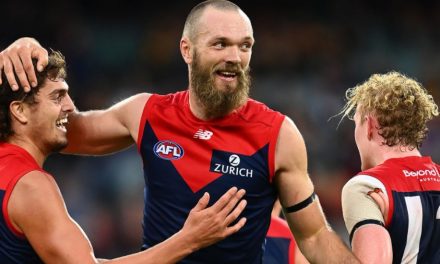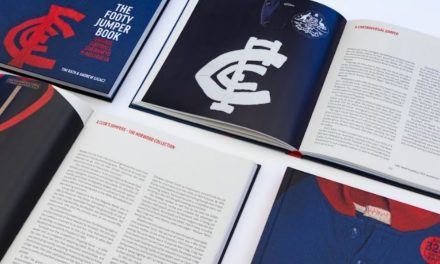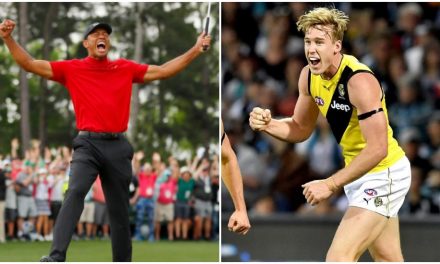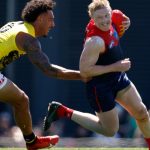Chris Judd (right) was one of the greatest footy players of all time – and Sam Walsh is tracking in the same direction. Photo: AFL MEDIA
Sam Walsh’s player profile in the AFL’s 2019 season guide rattles off an impressive list of junior football honours. It adds: “The Blues are confident he can step straight in and eventually provide a long-term boost to their midfield.”
Just two-and-a-half years down the track, that line is shaping as one of the bigger understatements modern football punditry has seen.
So much so that Walsh’s career trajectory is starting to look ominously like that of one of the greatest players of all time, a former Blue (later on) in dual Brownlow medallist Chris Judd.
Walsh’s starring role in Carlton’s comeback win over Collingwood last Sunday was just his 56th game of AFL football. Has any player since Judd played a more impressive first 50-odd games, particularly one who turned 21 only three weeks ago? The contenders don’t exactly leap to mind.
Perhaps the parallels will continue. Judd finished third in West Coast’s best-and-fairest in his debut 2002 season. He was runner-up the following year. In his third, he won both the Eagles’ best player award and a Brownlow Medal.
Walsh was fourth in Carlton’s John Nicholls Medal in 2019 and runner-up to Jacob Weitering last year. He’d be unbackable to win it this season. And he’s currently sixth favourite for the Brownlow at $10.
The path of early AFL draft selections can be a bumpy ride. Even Judd had to wait a week into that 2002 season to make his West Coast debut.
Champions the calibre of Nick Riewoldt and Luke Hodge had to bide their time, injury keeping Riewoldt to just six games in his debut season, Hodge having to cool his heels for a good month before he was picked at senior level.
But Walsh’s AFL career to date has been as seamless as what he put on show at junior level. His first game of his first season was also Carlton’s first, in front of 85,000 people at the MCG against Richmond.
Walsh didn’t miss a beat, picking up 24 possessions and playing a leading role in Carlton’s fightback from a near seven-goal deficit to draw with 12 points of the Tigers. He hasn’t missed a single game since then. And, really, that sort of performance has been the case on a weekly basis ever since.
His 39 disposals against Collingwood last Sunday was a career high, but only one more than the 38 he compiled against Adelaide a month ago, two more than the 37 he gathered against Fremantle in round three.
According to Champion Data, since 1999 only three players – Melbourne’s Clayton Oliver, GWS’s Toby Greene and Fremantle’s Michael Barlow – have compiled more disposals across their first 56 games than Walsh.
Even here, however, there are some significant “buts”. Barlow was 25 when he reached his 56th game, a senior player who had bided his time in VFL ranks before debuting with the Dockers at the age of 22. And all of Greene and Oliver’s first 56 games were full length games.
PLEASE HELP US CONTINUE TO THRIVE BY BECOMING AN OFFICIAL FOOTYOLOGY PATRON. JUST CLICK THIS LINK.
Seventeen of Walsh’s 56 came in last year’s adjusted game lengths, games 20 per cent shorter in duration than those played before or since. That’s 30 per cent of them. Yet even with that handicap, he averages just two disposals per game less than Oliver and only fractionally less than Greene and Barlow.
Now think of the contemporary greats of the game. The four names which come most obviously to mind are Dustin Martin, Nat Fyfe, Marcus Bontempelli and Patrick Dangerfield.
As good as “Dusty” was from his 2010 debut for Richmond, he reaped only a best-and-fairest third in his first three seasons, and was frequently the subject of some debate about both his “engine” and his best position.
Fyfe, similarly, had one best-and-fairest placing to show for his first three seasons and missed a slice of games through injury. “The Bont”, like Hodge, was kept waiting a month to make his 2014 debut for the Dogs.
He did finish third in a best-and-fairest in his second season, and won it in his third, a premiership year no less, but was more of a forward and peripheral midfielder early, reflected in disposal averages of just 16 and 21 in his first two years.
Dangerfield, meanwhile, spent his first year as a listed Adelaide player completing school in Victoria, making just two appearances, and didn’t really hit his straps as an AFL player until 2012, by which time he’d already played more than 60 games.
Nearly all of those contemporaries have also had the benefit of taking their first steps in decent teams which regularly played finals. Walsh has had to do so in a side chronically bereft of quality midfielders, he and Patrick Cripps from his very first game having to shoulder the vast bulk of responsibility.
And in 2021, with Cripps struggling under the weight of debilitating injury, Walsh has often had to do it all on his own. But as high a level at which Walsh’s AFL career began, his curve nonetheless just continues to climb.
The disposal average of 25 in 2019 has now grown to more than 30. He’s a more prolific tackler, wins more clearances, contested possession, and has increased his disposal efficiency. He’s hitting the scoreboard frequently, too (yes, another hallmark of Chris Judd).
It’s been an incredible first 50 games by the No.1 draft pick of 2018. And were Walsh to cap off his third season with the Brownlow, as Judd did, he’d also be the youngest winner since the 2006 Eagles premiership captain who received his first just 12 days after his 21st birthday (and went on to win another one six years later).
The comparisons are becoming more striking by the week. And being bracketed with a name like Judd carries a fair amount of pressure. But given how he’s handled himself thus far, does anyone seriously doubt that Walsh will cope with even that sort of burden just fine?
This article first appeared at ESPN.











